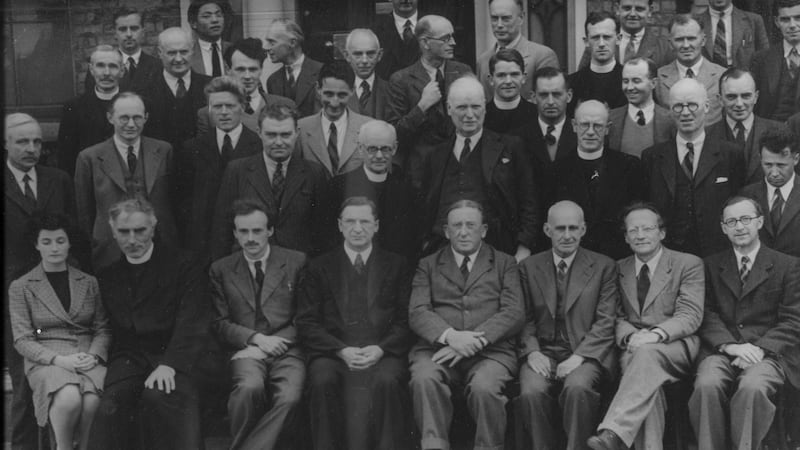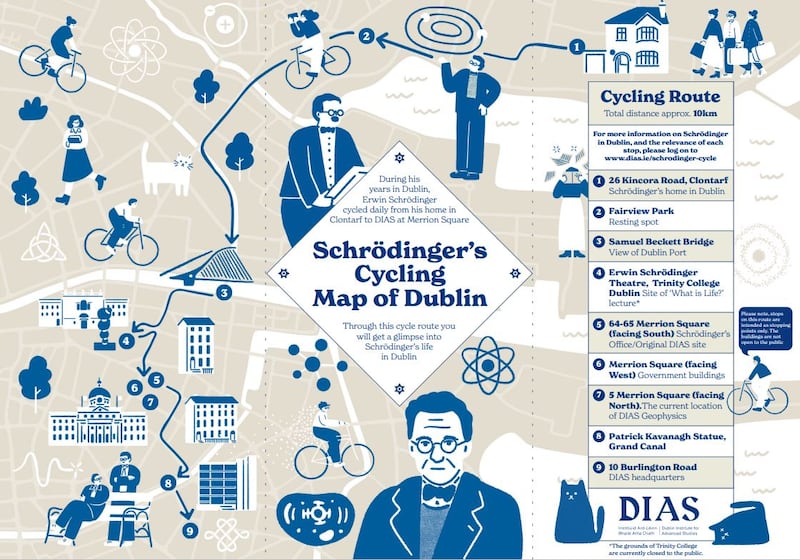In the parsimonious era of the late 1930s, Éamon De Valera used his Fianna Fáil majority in the Dáil to ram through what some saw as a vanity project. He parachuted someone in to give weight to a new institute, paying the appointee £1,200 a year – equivalent to half of the then taoiseach’s salary. There was no tender. No open competition. No interview.
Such were the circumstances of Erwin Schrödinger’s arrival to Ireland to help found the Dublin Institute for Advanced Studies (Dias). He was aged 52 when he took up the post in November 1939 and he spent the next 17 years based in Dublin – describing the period as “the happiest of my life”.
Today you can follow in his footsteps – or more precisely his cycle tracks – as a new self-touring guide is launched in recognition of Schrödinger’s attachment to the Irish capital. The Austrian physicist cycled daily from his home in Clontarf to Dias at Merrion Square – and the 10km cultural trail takes in sites associated with his stay.
Another close friend was Irish Times satirist Brian O'Nolan (Myles na gCopaleen) who penned a notorious review of a Trinity College Dublin debate in which Schrödinger participated in 1942
The absence of the interview for the job was understandable – Schrödinger had a Nobel Prize under his belt but, more immediately, was at risk from Nazi purges in Austria. His unconventional personal life – he lived for many years with two women at once – caused consternation in Oxford where had he initially sought work.
De Valera knew of his plight and moved fast to offer him the post in Dublin. The mathematician-turned-taoiseach was seeking a marquee name to build his new institute around. Schrödinger jumped at the chance to flee Graz.

One of the best friends in Dublin was a priest – Monsignor Paddy Browne who, like Dev, overlooked Schrödinger’s womanising in the interest of bolstering Ireland’s scientific reputation. Having arrived with “two wives” and a child, Schrödinger fathered two further daughters with two other women while in Ireland. You might expect Catholic Ireland to be aghast, as the Austrian’s biographer John Gribbin says, “but in Dublin at least there was a marked contrast between what was officially approved and what people actually did”.
Another close friend was Irish Times satirist Brian O’Nolan (Myles na gCopaleen) who penned a notorious review of a Trinity College Dublin debate in which Schrödinger participated in 1942.
O’Nolan wrote: “I understand also that Prof Schrödinger has been proving lately that you cannot establish a first cause. The first fruit of the Institute, therefore, has been an effort to show that there are two St Patricks and no God. The propagation of heresy and unbelief has nothing to do with polite learning, and unless we are careful this Institute of ours will make us the laughing stock of the world.”
Schrödinger was a keen cyclist and hiker – he was on a solo trip on his bike to Connemara when he learnt of Germany's invasion of the Netherlands
Schrödinger – famous for his somewhat Mylesian thought experiment about the cat that was and was not there – laughed off the column. But Dias was furious and sought and received an apology from The Irish Times. The paper also paid £50 to the Red Cross to resolve the matter even though Schrödinger had written to say: “I beg to decline emphatically the inclusion of any statement about my having been grieved by that article… or of anything that gives the wrong impression that I have asked for an apology.”
Schrödinger returned to Trinity the following year to deliver his famous What Is Life? public lectures, which were attended by De Valera, church leaders and Dublin’s intellectual elite. The lectures helped to pave the way for a golden era in molecular biology, and had a major influence on James Watson and Francis Crick’s discovery of DNA’s double helical structure in 1953.
Schrödinger was a keen cyclist and hiker – he was on a solo trip on his bike to Connemara when he learnt of Germany’s invasion of the Netherlands. The shortage of coal and oil during “the Emergency” led to private cars disappearing from the streets of Dublin after 1942, making his daily commute from 26 Kincora Road a particularly pleasant one.
He rented the house until 1943 when he bought it for £1,000. He sold it for £2,150 when the family left Dublin in 1956. Five years later, he died in Vienna aged 73.

* The Schrödinger cycling map can be downloaded from Dias and hard copies can be collected from the institute's offices at 10 Burlington Road, where you can also collect a postcard at end of your cycle. The map was launched as part of the opening of the Dublin Festival of History, which runs until October 10th, with over 100 free events: dublinfestivalofhistory.ie
* On Wednesday, September 22nd at 6pm, Professor Gisela Holfter, co-founder, and director of the German Irish Studies Centre at the University of Limerick, will present a talk "Safe Haven: Dias and the WWII immigrants who helped shape it", exploring the backgrounds of the academics who fled to Ireland to escape Nazi Germany and came to Dublin to work at the institute. See dias.ie











